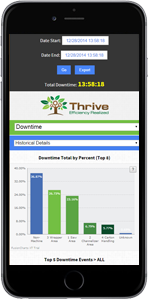Organizational leaders in the apparel and textiles industries are facing a number of significant challenges, essentially all at the exact same time.
For starters, utility costs are only expected to rise over the next few years – eating into the already thin profit margins for companies that depend on things like electricity, water and compressed air to make their products. Not only that, but apparel and textiles also require specialized, skilled employees that aren’t as readily available as they once were due to various labor shortages and skills gaps.
Political instability, demand that exceeds supply – you name it, it’s a hurdle for the industry to overcome. Thankfully, OEE or Overall Equipment Effectiveness can dramatically help. By improving performance and resource utilization across the board, OEE can help businesses accomplish more with less – rising to overcome these and other challenges without worrying about compromising quality in the process.
Tracking Performance is the Key to Improving Performance
One of the major advantages of OEE tracking is that it allows you to take a “bird’s eye view” look at your entire operation, quickly identifying which of your current efforts are working and, more importantly, where your losses are.
OEE measures three things – quality, performance and availability. If you were able to achieve an OEE score of 100% (you won’t and, don’t worry, that is not uncommon) that means you would be manufacturing only the highest quality products as quickly as possible with absolutely no stop time getting in the way.
Again – getting to 100% is essentially impossible, but that’s okay because the process still gives you invaluable insight into what you can do with regard to continuous improvement. If performance factors are dragging down your OEE score, you’ll know about it immediately – putting you in a better position to fix whatever the problem is. If stop time is the problem, you can take a look at things like shift changeovers and planned downtime to see which of these tasks are taking longer than they should.
Obviously, paying attention to quality is always important, but it’s especially so in the context of textiles and apparel. As the quality component of your OEE score begins to tick upwards, you’ll be dealing with fewer garments and other items that are ultimately rejected or that need to be reworked. You’ll be able to see which machines may be malfunctioning and need to be repaired, versus which ones should be replaced outright. In essence, you’ll have “the full story” regarding what is going on with your business – all so that you can take the most strategic approach possible in terms of overcoming the challenges like those outlined above.
If you’d like to find out more information about the major benefits that OEE software brings with it to the textiles and manufacturing industries in particular, or if you’d just like to see how your organization stands to gain from a customized manufacturing KPI dashboard to call your own, please don’t delay – contact Thrive today.

